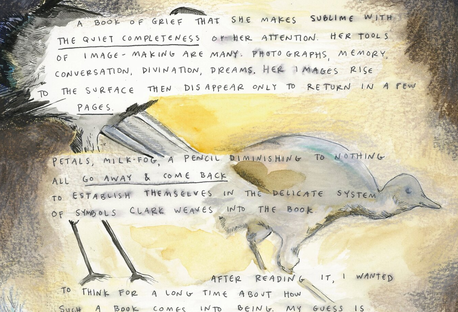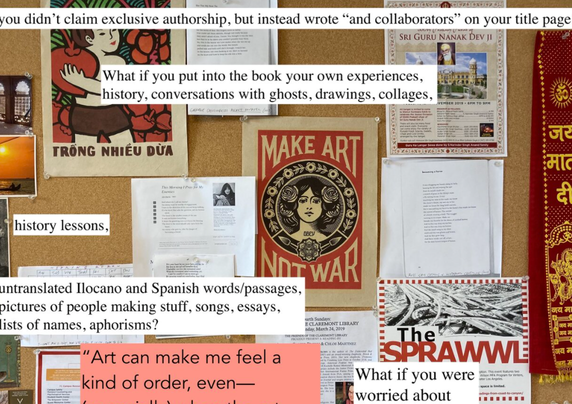Creative Poetry
I would like to propose the term "Creative Poetry" to mean "Visual Poetry", "Graphic Poetry", "Visual Erasure Poetry", "Graphic Found Poetry", "Graphic Book Review", and many new poetry branches.
Often my audiences are often confused by the differing terms "Visual Poetry" and "Graphic Poetry'. I would like to say that the overall idea is the same.
I used "Graphic Poetry" because my graphic poems were more focused on story-telling than visual elements when I created my book. The term is related to "Graphic Novel" in the sense that visual elements tell a main plot and side-story (Emaki elements) while written words support and punctuate the narrative.
Though the term "Creative Poetry" may be useful to use in this website. "Creative Poetry" contains visual storytelling elements beyond traditional poetry writing.
Often my audiences are often confused by the differing terms "Visual Poetry" and "Graphic Poetry'. I would like to say that the overall idea is the same.
I used "Graphic Poetry" because my graphic poems were more focused on story-telling than visual elements when I created my book. The term is related to "Graphic Novel" in the sense that visual elements tell a main plot and side-story (Emaki elements) while written words support and punctuate the narrative.
Though the term "Creative Poetry" may be useful to use in this website. "Creative Poetry" contains visual storytelling elements beyond traditional poetry writing.
How to Create Images
I have been curating RHINO Poetry (Book Review) Graphic Issues since 2019.
Observing the following reviewer's techniques is the best way to understand how to adapt imagery into your creative poetry projects.
All methods take time to master. There are no easy techniques, but some may fit the art style you are going for better than others.
Observing the following reviewer's techniques is the best way to understand how to adapt imagery into your creative poetry projects.
All methods take time to master. There are no easy techniques, but some may fit the art style you are going for better than others.
Methods:
- Pen and Pencil
- Colored Pen & Pencil, Pastel, Crayon, Watercolor
- Paper Collage
- Photo Collage
- Digital Collage
- Digital Art (Animation, Movie, etc.)
Pen and Pencil
This is perfect for creating your first creative poem because you do not need to purchase any new materials. You simply need a pen, pencil, and notebook.
Examples:
Anthony Madrid - National Audubon Society Birds of North America, National Audubon Society Guide (Knopf, April 6, 2021 )
David Morgan O'Connor - The Trojan Women: A Comic by Anne Carson and Rosanna Bruno (New Directions, May 2021)
Frances Cannon - Writers & Lovers by Lily King (Grove Press, March 2020)
Examples:
Anthony Madrid - National Audubon Society Birds of North America, National Audubon Society Guide (Knopf, April 6, 2021 )
David Morgan O'Connor - The Trojan Women: A Comic by Anne Carson and Rosanna Bruno (New Directions, May 2021)
Frances Cannon - Writers & Lovers by Lily King (Grove Press, March 2020)
Colorful Pencils & Pens, Pastels, Crayons, Watercolor
If you have colored materials and a heavy duty paper (for watercolor & pastels), you may add more colorful elements to your projects.
Example:
Meg Reynolds - Lyrebird by Meredith Clark (Platypus Press Ltd, October 2020)
Example:
Meg Reynolds - Lyrebird by Meredith Clark (Platypus Press Ltd, October 2020)
Paper Collage
If you like finding interesting papers (cards, magazines, old notes, photos, origami, advertisements, and other materials), you may like gluing them onto your works.
Examples:
Jennifer Steinorth - Mother/Land
Kelly Cressio Moeller - What Pecan Light by Hannah VanderHart (Bull City Press, April 2021)
Naoko Fujimoto - prepoems in postspanish and other poems by Jorgenrique Adoum Translated by Katherine M. Hedeen and Victor Rodriguez Nunez (Action Books, March 2021)
Examples:
Jennifer Steinorth - Mother/Land
Kelly Cressio Moeller - What Pecan Light by Hannah VanderHart (Bull City Press, April 2021)
Naoko Fujimoto - prepoems in postspanish and other poems by Jorgenrique Adoum Translated by Katherine M. Hedeen and Victor Rodriguez Nunez (Action Books, March 2021)
Photo Collage
I like this method because if you are uncertain about your drawing or collage skills, you can take pictures and add them to your text.
Example:
Martinez organized and took a photo of her office wall. Then, she added her texts.
Example:
- Chloe Martinez - Atang: an altar for listening to the beginning of the world by Patrick Rosal (Quili-Quili Power Press, 2021)
Martinez organized and took a photo of her office wall. Then, she added her texts.
Digital Collage
Digital Collage is becoming more popular with the use of apps and phones.
(This method has the advantage of eliminating steps traditional photo art has (like picture development, scanning, high-resolution filtering, etc.), but cannot always replicate traditional photography with its varied techniques)
Examples:
(This method has the advantage of eliminating steps traditional photo art has (like picture development, scanning, high-resolution filtering, etc.), but cannot always replicate traditional photography with its varied techniques)
Examples:
- Crystal Simone Smith - Just Us: An American Conversation by Claudia Rankine (Graywolf Press, September 2020)
- Ina Carino - The Wild Fox of Yemen by Threa Almontaser (Graywolf Press, April 2021)
- Tricia Lopez - Piñata Theory by Alan Chazaro (Black Lawrence Press, August 2020)
Digital Art
This is an exciting new method. I see more movies, animations, short films, and digitally processed art being published now than ever.
Examples:
Examples:
- Aaron Caycedo Kimura - Animation - Seize by Brian Komei Dempster (Four Way Books, September 2020)
- Rodney Gomez - This review can be read when readers zoom in the computer screen.



